Discovery Phase is one of the most discussed topics in the business world. It helps businesses to complete their digital projects faster and within the budget.
According to research conducted by McKinsey:
- 17% of unsuccessful IT projects become the reasons for the collapse of the company.
- 7% of the IT projects increased the cost by being delivered way after the deadline.
- 45% of IT projects always cross the set budget.
To address these concerns, careful analysis and planning are crucial for business, and here comes the role of the Discovery Phase.
Over 70% of IT project development companies require a discovery phase before tackling the project. In this article, we will delve into the specifics and answer the question of "What is a discovery phase and why should you care?".
What is Discovery Phase
A successful discovery phase allows you to get the majority of the risk out of the way. It creates the concentration that is required for effective and timely growth.
The discovery phase, also known as scoping, is the process of initial research and gathering and evaluating details about the project, its target market, and its target audience. It provides for a comprehensive and in-depth grasp of the objectives, scope, and restrictions.
The end-users, their demands, and requirements are better understood during the business discovery stage. The technical part of the process leads to the system requirements specification (SRS).
This document contains information required for the development—for example, primary and additional features, measurable deliverables, and more.
Project managers have traditionally divided the project life cycle into five stages: initiation, planning, execution, control, and closure.
- Initiation
- Planning
- Execution
- Control
- Closure
Now, let’s move to the important phases of the discovery process.
4 elements of a successful discovery phase
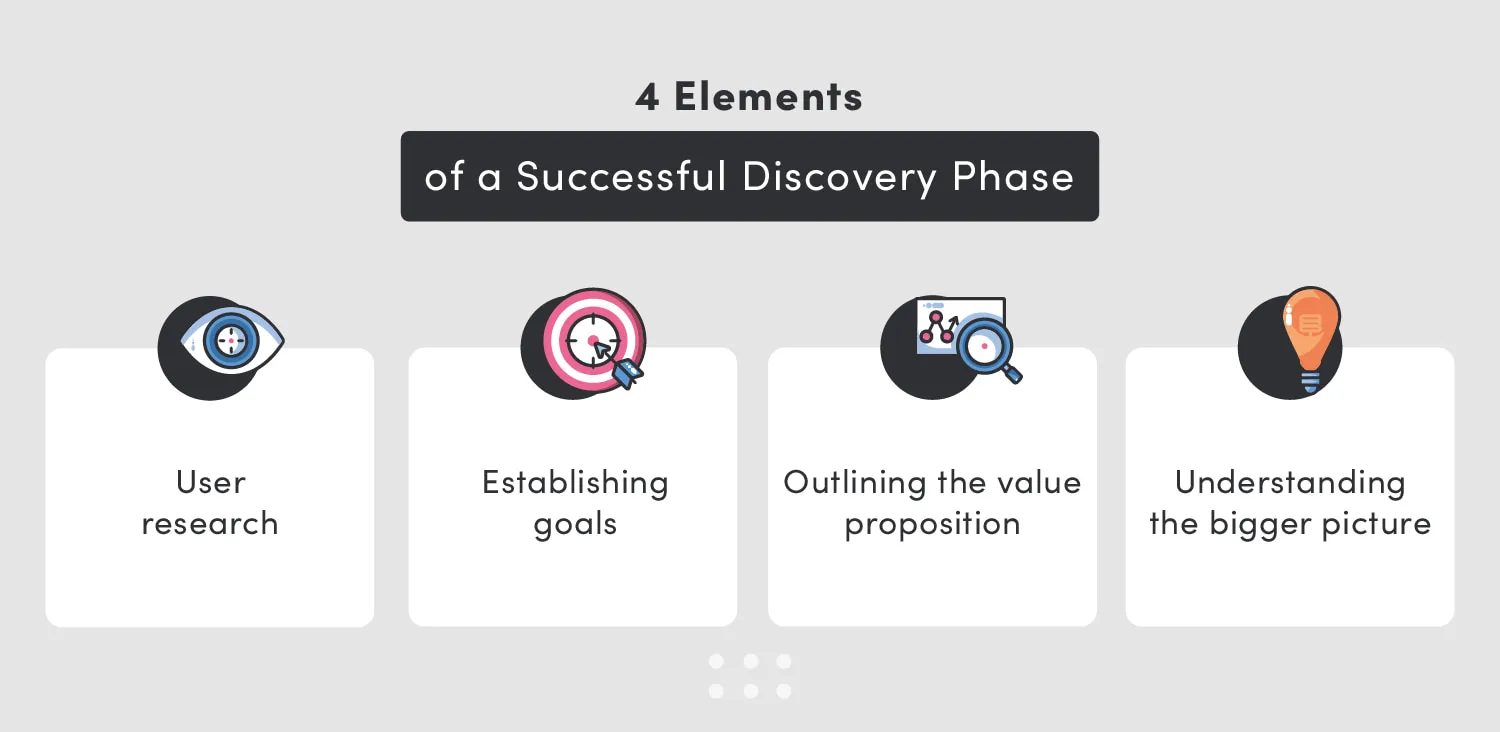
As I mentioned at the beginning of this article, a discovery phase usually entails:
- Performing user research.
- Defining success and establishing goals
- Outlining the value proposition.
- Understanding the bigger picture.
Let’s look at each of them in detail.
Performing User Research
Any user experience expert will tell you that knowing the user is the most important goal of the exploration phase.
Senior management can generally speak fluently about their company's aims, product offerings, and even the overall market. However, when it comes to the user, they are frequently under-informed simply because they do not interact with them regularly.
It is very important that companies carry surveys and research to gather users' expectations, demands, and buying trends to get more clarity about the product.
Defining Success Metrics and Establishing Goals
Although the two are intertwined, one might argue that defining a digital project's goals and what success looks like is more important than understanding the user's demands.
The project will be directionless and prone to scope creep if there are no defined objectives and definitions of success. Most importantly, without specific goals, stakeholders will be unable to determine whether or not the initiative was a success.
Of course, the ultimate criterion for a project's success or failure is whether it provides a return on investment. However, the nature of that return might vary, so it's vital to specify it upfront. For example, suppose one stakeholder expects a financial return in increased sales or leads, while others are concerned with enhancing the experience or engagement. In that case, it might generate friction in a project.
Outlining the Value Proposition
The value proposition of service is something that many people seem to miss throughout the exploration process. Stakeholders are so fixated on objectives, and user experience experts are so concerned with user demands that no one asks what value the service offers to the consumer and if it meets their genuine needs.
Depending on the nature of the digital service, the focus of your value proposition shifts somewhat.
Assume you are in the exploration phase of a project and looking at a mobile app or software for a service website. The value proposition in this scenario will be the digital service itself.
Understanding the Bigger Picture
The larger environment of a digital project will again differ depending on the service's nature. In most cases, though, this will include the following:
Internal considerations
This is a courteous term that refers to any internal politics that might sabotage the project. However, it can also refer to technical limitations or difficulties with compliance.
An overview of relevant services that are presently available. It's a good idea to evaluate an existing version of the service before starting with a redesign. It's also worth investigating alternative platforms or services related to the project.
This might include technological platforms and services that came before or after the service you are redesigning in the user journey.
The environment is competitive
What are your competitors doing, and how will you position your digital service in the larger market?
Influencers. Will the project be influenced by other persons or factors? For example? Are there any partners, regulatory authorities, or industry figures/bodies that you need to impress?
Getting the answers to these questions is a must.

Try our developers.
Free for 2 weeks.
No risk. Just results. Get a feel for our process, speed, and quality — work with our developers for a trial sprint and see why global companies choose Selleo.
Why is the Discovery Phase Essential?
Discovery Phase helps in allocating the right budget and time to a project. It is essential because:
It Focuses on Objectives and not Just Deliverables
The fact that a project is completed on time and within a budget does not ensure its success. Not even if the project adheres to the specifications to a tee. These aren't definitions of success. The product's success is measured by how well it achieves broader objectives, such as boosting leads or improving conversion.
It's easy for a project to lose focus and direction throughout production if it doesn't have that clear vision. A well-run discovery phase should resolve this problem.
Regrettably, these fundamental goals aren't adequately defined or communicated. It's easy for a project to lose focus and direction throughout production if it doesn't have that clear vision. A well-run discovery phase should resolve this problem.
It Leads to Better Solutions
The digital team can better grasp the idea during the discovery phase. They gain a better understanding of the fundamental factors rather than merely the client's solutions. Therefore, the discovery phase leads to better business solutions.
After the digital team has gained a thorough understanding of the project's context, they may suggest alternate solutions. Solutions that a customer (who is not a digital specialist) may not even be aware of are feasible - solutions that are frequently better or less expensive than the client's proposal.
It Provides Broader Context
Finally, a discovery phase establishes a framework for the numerous decisions made daily throughout the project. It will cut down on expensive errors, misunderstandings, and redundant functions.
The more educated the digital discovery team is, the faster they can make the appropriate judgments and the better the end solution.
You should now be able to appreciate the value of a discovery phase. The issue then arises, "How do you operate one that is successful?"
It Highlights the User
A functional specification, often known as a client brief, is rarely prepared with the user in mind. It's usually a lot worse. We frequently define projects without prior determination of what the user desires or requires.
Read also: Airbnb's Strategy for Growth - Step by Step
It's risky to forget about the user. It is simple to create functionality or content that no one wants, which is a huge waste of money.
We still need to give the digital team time with users even if we've done some user research. They will make project judgments that will undermine the user experience if they do not understand the user.
Benefits of Discovery Phase
Here’re some of the major benefits of the Discovery Phase.
- The goal of the project is more defined, resulting in a more accurate estimate.
- Make design decisions based on data rather than guesswork.
- Ensure a higher return of investment
- Create a user-friendly experience.
- During the advanced phases of the development process, avoid the necessity for costly modifications.
- Early involvement of in-house experts will maximize the impact of their expertise on the problem to be solved.
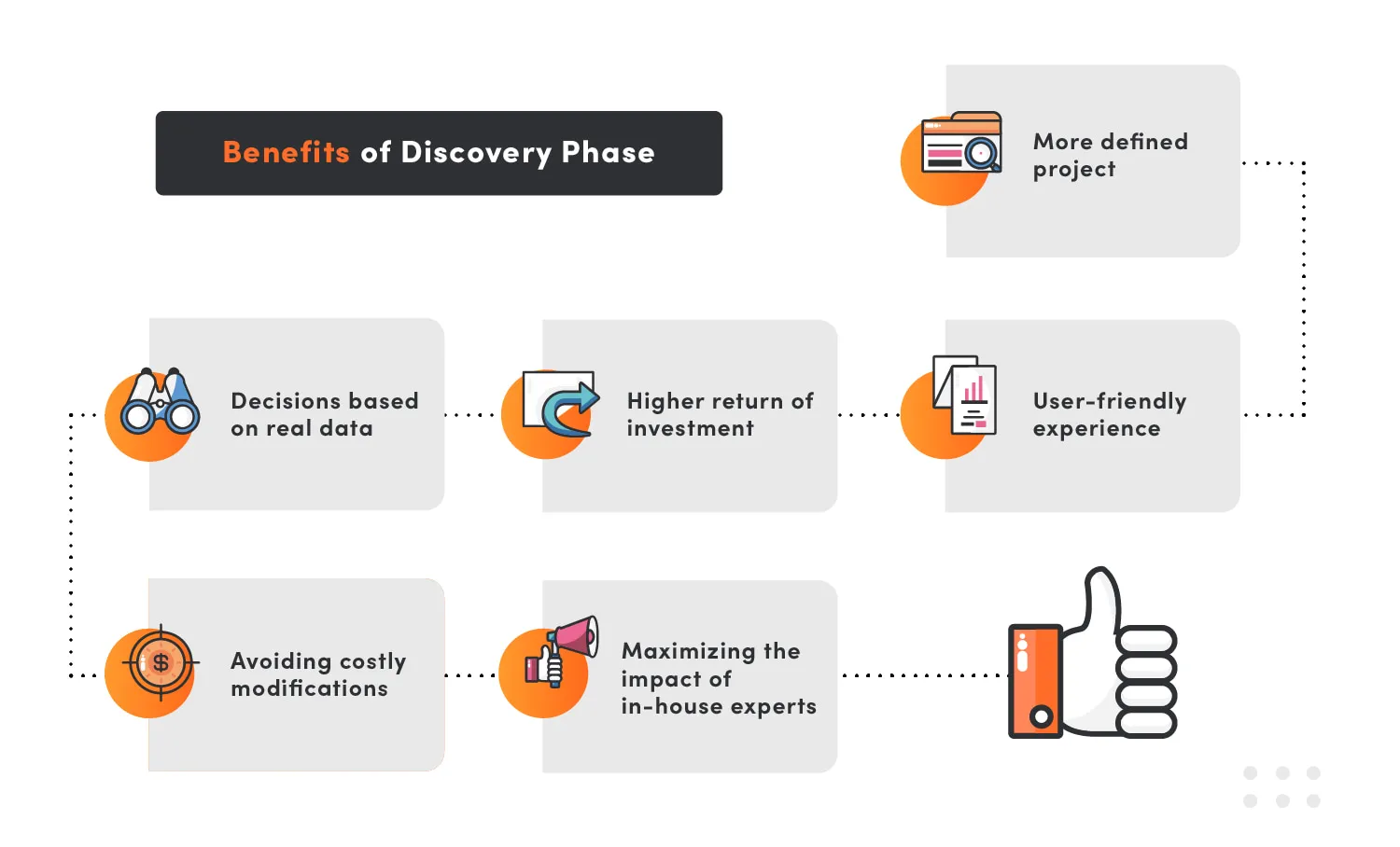
Skipping discovery phase can result in the following:
- Never-ending scope creeps. Due to a lack of quantifiable expected results, projects might be continually extended, resulting in a delay in their completion.
- Climbing costs. Goals and objectives that are unclear lead to changes in direction and additional costs.
- Missed deadlines. Delays in launch might occur if project boundaries are not well defined.
- The project doesn't meet your expectations. An early mistake can develop to further uncertainty, later on, squandering time and money.
Discovery Phase Stages
The Discovery Phase is divided into different stages. Let’s look into each one of them in detail.
Business Analysis Explained
This phase combines two key elements to get a high-level overview of the problem we want to solve.
Document business model vision using strategic management tools to outline the value proposition, understand the end-users, income and cost drivers, required resources, key stakeholders, and relationships with customers. It should also answer the question: What will be the most important features that solve the customers' problem?
Deliverables of this phase
- Business Model Canvas
- A prioritized list of features created with the MoSCoW method that answers to end-users needs
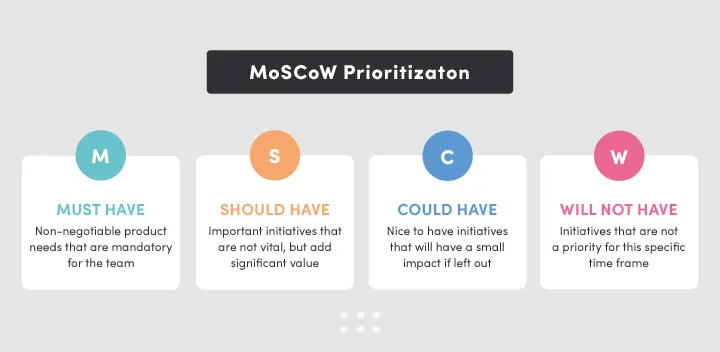
Benefits of Business Analysis
Here’re some of the benefits of the Business Analysis Stage.
Eliciting Requirements for a Project
In collaboration with all stakeholders, including software engineers, project managers, product owners, corporate leadership, and workers, the BA compiles all required technical and business criteria for a minimal viable product (MVP) or final product.
Customers or end-users should be included in this study since they are the ones who will use the product and are the ideal people to tell you about its functionality, as well as its difficulties, triumphs, and failures.
Communication Bridge between stakeholders
The business analyst serves as a link between stakeholders and the development team, competent in interpreting business needs into technical language for developers and engineers. Simultaneously, the BA conveys the project team's issues to the relevant stakeholders, ensuring that all group members are well-informed and understood across silo boundaries.
Project implementation and testing
The project's actual construction or development phase entails designing and executing the application or software solution necessary to meet business requirements in the form of a successful, functional product.
Working alongside the testing team to analyze features and general functionality of the application as it is being created, business analysis plays an important role in implementation and testing.
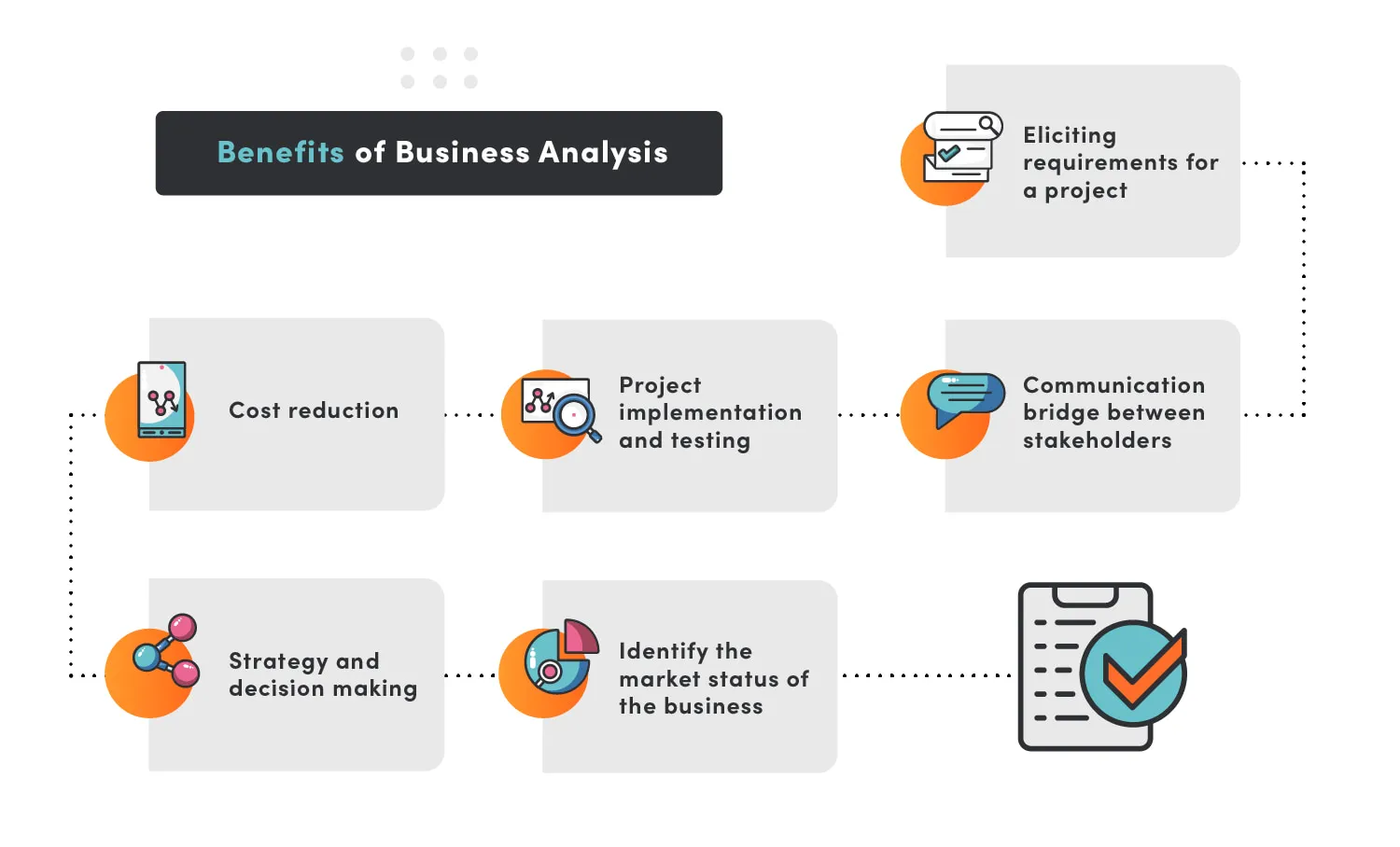
Cost Reduction
One of the most important benefits of business analysis is that it may assist in cost reduction. BAs analyze data and suggest work techniques to develop cost-cutting solutions for projects.
The BA informs the team on how to work and supervises the operation for any problems or possible efficiency improvements, depending on the software development methodology the team is using (Waterfall, Agile, Scrum, Lean development, etc.). This reduces expenses and improves the completed application's time to market (TTM).
Strategy and decision making
Perhaps the key advantage of business analysis is its capacity to assist stakeholders and investors make more informed decisions on behalf of the company. Organized, rational conversations about how the company has been performing in the industry, where the trouble spots or possibilities are, and what variables govern the increase of company expenses or how to attain a better profit margin are all variables that impact decision-making and provide clarity for employees.
Identify the market status of the business
Business analysis excels in determining where your company is concerning the overall market picture, its benefits to consumers and stakeholders, and who your closest rivals are. Information about your consumers and competitors is readily available through modern data analytics.
It's not clear, however, what emotional values and demands your software product helps to satisfy, what obstacles and successes end users have when using it, or how your product roadmap fills a need that rivals have failed to load.
Read also: How To Run Your First Event Storming Session
What are the Business Analysis stages?
1. Get Well Oriented
The following tasks should be the main focus in this step:
- Defining and clarifying your responsibilities as a business analyst
- Identifying the key stakeholders
- Creating a clear picture of the project and its history
- Identifying the current systems and procedures
2. Identify the Primary Objectives of the Business
Responsibilities in this step are as follows:
- Identifying the expectations of the major stakeholders
- Bringing together any competing expectations and establishing a common understanding of the goals
- Make sure that all of your company's goals are clear and realistic.
- Making sure the business objectives set the stage for successfully defining the scope
3. Define the Scope
The primary tasks in this stage are to:
- Define a technique for determining the type and scope of necessary technical and process changes.
- Prepare a clear scope statement and go through it with your stakeholders.
- Confirm the feasibility of the project.
4. Create Your Business Plan
Key responsibilities in this phase are:
- Selecting the most appropriate forms of the deliverables
- Defining a specific list of deliverables, covering the scope, and identifying the stakeholders
- Creating timelines for completing said deliverables
5. Define and Detail the Requirements
Key responsibilities in this stage are:
- Information gathering and collating
- Analyzing the data and incorporating it into the first draft
- Examining and approving the specified deliverables
- To fill in any gaps, ask questions.
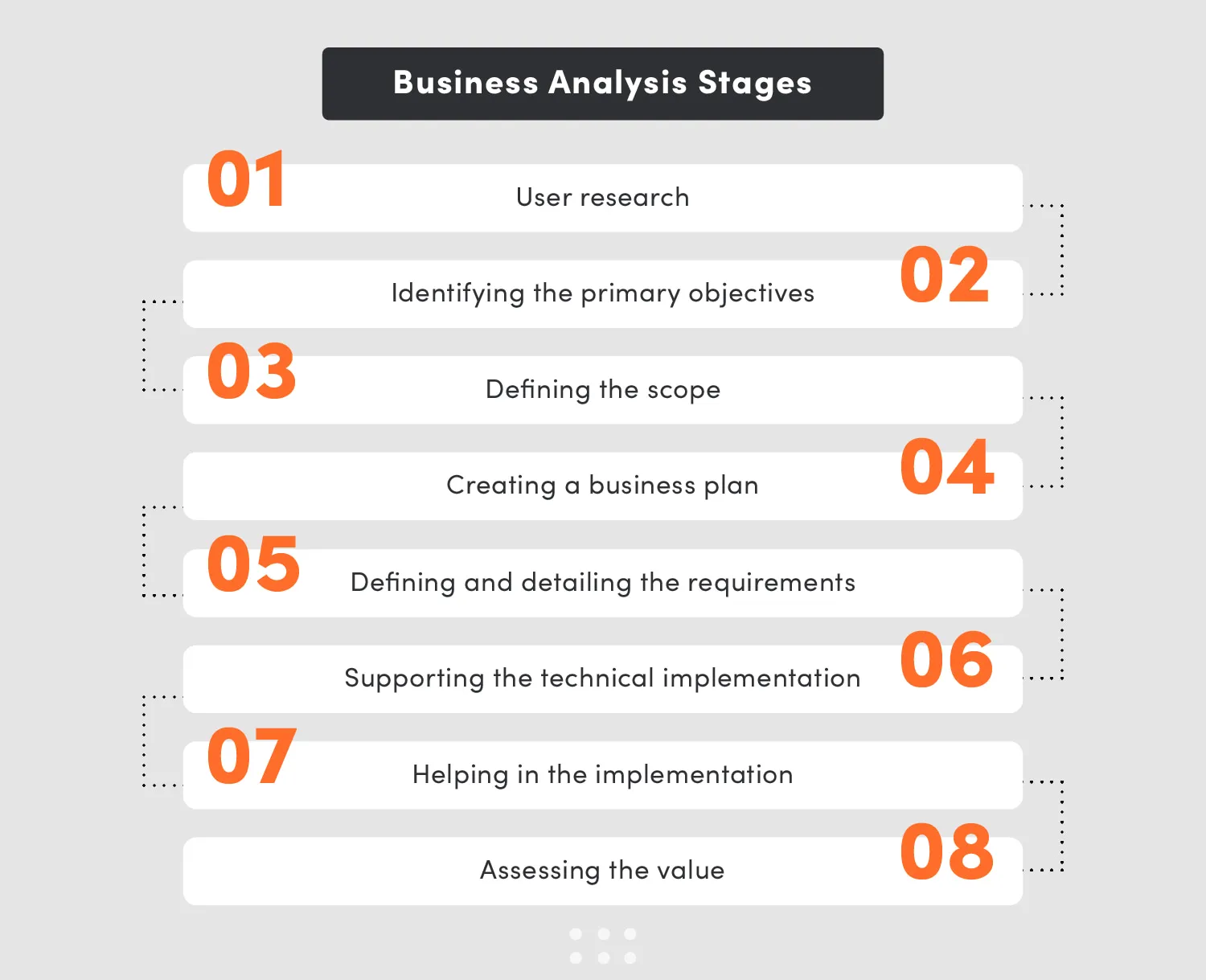
6. Support the Technical Implementation
Assessing and reviewing the final Solution
- Updating the requirements document
- Working with quality assurance professionals, ensuring they know the importance of the technical requirements
- Managing requirement changes
- Leading user acceptance testing if possible
7. Help the Company Implement the Solution
Critical steps in this stage are:
- Analyzing and creating interim business procedure documentation that specifies what modifications should be done
- End-user training, ensuring that they are aware of any procedures and procedural modifications
- Working closely with business users
8. Assess the Value Created by the Solution
Primary responsibilities in this step are:
- Evaluating actual progress
- Informing the project sponsor, team, and other members of the company of the results
- Proposing follow-ups
A Discovery Workshop - Event Storming as a perfect solution
- Event Storming - a workshop-based approach for rapidly exploring complicated business processes and domains by bringing together all project stakeholders, including developers and non-technical users.
- Big picture - Enables exploration of the whole company line, looking for divergent stakeholder interests and viewpoints. As a result, we have a massive map of the group's business understanding.
- Process Level Modelling - This allows you to model a single business process from beginning to end while ensuring no ambiguities and all business rules are clarified.
Benefits of conducting an Event Storming Session
- A thorough and shared understanding of the business process and flow, identifying discrepancies or roadblocks and removing them before implementing the process.
- It cuts the time it takes to build a thorough business domain model in half.
- Effective is efficient because it produces a fully functional behavioral model that can be easily deployed and evaluated.
- It is a hands-on approach to domain modeling that encourages everyone to engage and interact. It's all about having talks and having debates.
- Straightforward - It lays down the procedure into easy-to-understand language for both technical and non-technical individuals.
What is a Delivery Roadmap in software development?
A product roadmap is a high-level visual description of your product offering's vision and trajectory across time. A product roadmap explains why and how you're creating something. A roadmap is a strategic document that also serves as a blueprint for carrying out the product strategy.
Why do we need a delivery roadmap?
The delivery roadmap aims to plan the sequence of feature development so that the correct item comes first (after the discovery phase) during the product delivery phase.
We concentrate on the most critical aspects of the company to verify solutions in the production environment as quickly as feasible.
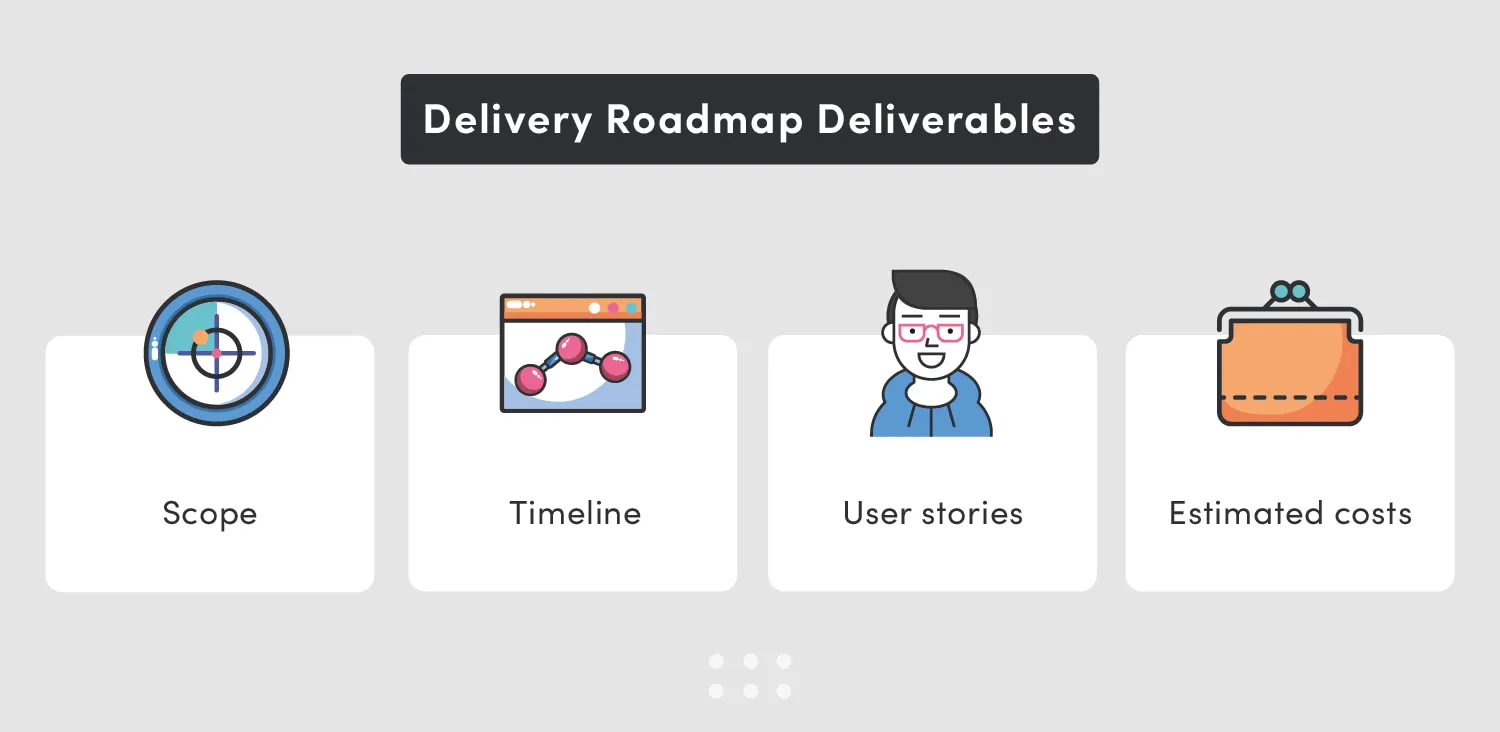
Roadmap deliverables:
- Scope - what are the most critical features of an MVP
- Timeline - Delivery sequence and shape of the delivery timeline
- User stories - describe features from the user perspective
- Estimated cost - evaluate the effort
Discovery Phase Checklist
The components of the checklist are as follows:
- Client/Company - The project's primary goals, research and marketing materials, and the reasoning for any alterations or revisions are all included in this area.
- Market - Using online and offline resources, do a comprehensive study concentrating on internal and external factors. White papers, subscriptions, and industry-related periodicals may also be included in the materials.
- Current Alternatives - Other marketplace offers, such as items and services, are available as alternatives. Buying habits, customer service quality, engagement models, and other variables are all important.
- Competitive Analysis - The evaluation of competing offerings as well as the sources of these services. Classifying rivals into online and offline categories, as well as primary and secondary groupings, is beneficial. The latter enables for the prioritization of risks and the effective and efficient response to their occurrence.
- Target Base - User tales, demographics, and consumer avatars are all included in this section.
- Marketing Strategy - The marketing plan includes short- and long-term objectives, branding, communication, and specific tactics.
- Technical Requirements - The significant components of technical requirements are specifications, solutions, and an updated technology package.
- Additional Data and Information - This element provides for a review of the other deliverables and the identification of any missing components. To ensure that the checklist is comprehensive, it is critical to ensure that all stakeholders are included in the process.
Summary
The Discovery Phase provides critical advantages in measurable results, quality analysis, strategic development areas, and a general methodical approach and communication. Before complete commitment from all stakeholders, it serves as a risk management tool. Overcoming skepticism and attempting to minimize costs ahead of time is critical for avoiding future risks.
If you are looking for a development company that has the expertise in Discovery Phase Strategies and Implementation, drop Selleo a line. Contact us to learn more about Discovery Phase and how to conduct one for your software project.





